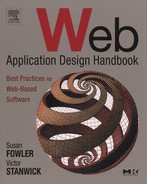Table of Contents
Critical Acclaim For WEB APPLICATION DESIGN HANDBOOK
The Morgan Kaufmann Series in Interactive Technologies
Chapter 1: What Is a Web Application?
What’s the Difference Between a Web Page and a Web Application?
Chapter 2: The Browser Framework
Browser Window: A Conceptual Model
Conceptual Model: Lists versus Objects
Use Fields to Collect Free-Form Information
Prevent Input Errors with Dropdown Lists
When to Use Regular Lists Rather Than Dropdown Lists
Prevent Input Errors with Checkboxes
Prevent Input Errors with Radio Buttons
Make Your Checkboxes and Radio Buttons More Accessible
When to Use Tabs Instead of Pages
How to Do Dates, Addresses, and Other Standard Input
Mosaic Pages: Syndication and Links
Consider Using Flash to Simplify the Interaction
List on the Left, Object on the Right
How to Select and Open Objects from Lists
How to Change Objects from Lists
Chapter 5: Data Retrieval: Search
Simple Search: Good for Uncomplicated Retrievals
Advanced Search: Good for Experienced Users
Complex Search: Good for Difficult Oueries
Be Careful with Error Messages
Chapter 6: Data Retrieval: Filtering and Browsing
Use Filtering to Control Overloads
Use Browsing When the Ouery Is Fuzzy
Chapter 7: Data Output: Reports
Let Users Print Ad Hoc Queries
Heavy Lifting: Management Reports
Chapter 8: Data Output: Printed Forms
Chapter 9: Interacting with Output
Designing the Formatting Window
Communication and Distribution
What to Do if There Are Too Many Records in the Report
Chapter 10: Designing Graphs and Charts
Data Rectangles Hold the Information
Chapter 11: Graph Types Based on Use
Chapter 12: Designing Diagrams
Use the Right Colors, Patterns, and Symbols
Should the Diagram Be Live or Recorded?
Engineering and Scientific Diagrams
Chapter 14: Designing Geographic Maps
Follow the Rules for Color on Maps
Chapter 15: Interacting with Geographic Maps
Overlay Information on Locations
Show How Data Are Distributed Geographically
Use the Right Method for the Data
Provide Decision Support and Analysis
